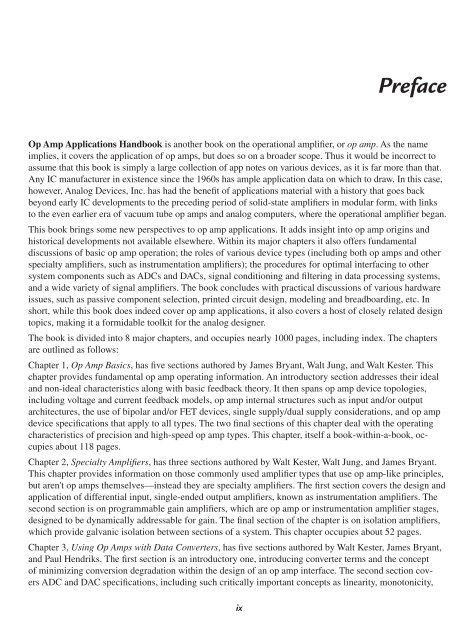Op Amp Applications Handbook Walt Jung, Editor
Op Amp Applications Handbook Walt Jung, Editor
Op Amp Applications Handbook Walt Jung, Editor
Create successful ePaper yourself
Turn your PDF publications into a flip-book with our unique Google optimized e-Paper software.
ix<br />
Preface<br />
<strong>Op</strong> <strong>Amp</strong> <strong>Applications</strong> <strong>Handbook</strong> is another book on the operational amplifi er, or op amp. As the name<br />
implies, it covers the application of op amps, but does so on a broader scope. Thus it would be incorrect to<br />
assume that this book is simply a large collection of app notes on various devices, as it is far more than that.<br />
Any IC manufacturer in existence since the 1960s has ample application data on which to draw. In this case,<br />
however, Analog Devices, Inc. has had the benefi t of applications material with a history that goes back<br />
beyond early IC developments to the preceding period of solid-state amplifi ers in modular form, with links<br />
to the even earlier era of vacuum tube op amps and analog computers, where the operational amplifi er began.<br />
This book brings some new perspectives to op amp applications. It adds insight into op amp origins and<br />
historical developments not available elsewhere. Within its major chapters it also offers fundamental<br />
discussions of basic op amp operation; the roles of various device types (including both op amps and other<br />
specialty amplifi ers, such as instrumentation amplifi ers); the procedures for optimal interfacing to other<br />
system components such as ADCs and DACs, signal conditioning and fi ltering in data processing systems,<br />
and a wide variety of signal amplifi ers. The book concludes with practical discussions of various hardware<br />
issues, such as passive component selection, printed circuit design, modeling and breadboarding, etc. In<br />
short, while this book does indeed cover op amp applications, it also covers a host of closely related design<br />
topics, making it a formidable toolkit for the analog designer.<br />
The book is divided into 8 major chapters, and occupies nearly 1000 pages, including index. The chapters<br />
are outlined as follows:<br />
Chapter 1, <strong>Op</strong> <strong>Amp</strong> Basics, has fi ve sections authored by James Bryant, <strong>Walt</strong> <strong>Jung</strong>, and <strong>Walt</strong> Kester. This<br />
chapter provides fundamental op amp operating information. An introductory section addresses their ideal<br />
and non-ideal characteristics along with basic feedback theory. It then spans op amp device topologies,<br />
including voltage and current feedback models, op amp internal structures such as input and/or output<br />
architectures, the use of bipolar and/or FET devices, single supply/dual supply considerations, and op amp<br />
device specifi cations that apply to all types. The two fi nal sections of this chapter deal with the operating<br />
characteristics of precision and high-speed op amp types. This chapter, itself a book-within-a-book, occupies<br />
about 118 pages.<br />
Chapter 2, Specialty <strong>Amp</strong>lifi ers, has three sections authored by <strong>Walt</strong> Kester, <strong>Walt</strong> <strong>Jung</strong>, and James Bryant.<br />
This chapter provides information on those commonly used amplifi er types that use op amp-like principles,<br />
but aren't op amps themselves—instead they are specialty amplifi ers. The fi rst section covers the design and<br />
application of differential input, single-ended output amplifi ers, known as instrumentation amplifi ers. The<br />
second section is on programmable gain amplifi ers, which are op amp or instrumentation amplifi er stages,<br />
designed to be dynamically addressable for gain. The fi nal section of the chapter is on isolation amplifi ers,<br />
which provide galvanic isolation between sections of a system. This chapter occupies about 52 pages.<br />
Chapter 3, Using <strong>Op</strong> <strong>Amp</strong>s with Data Converters, has fi ve sections authored by <strong>Walt</strong> Kester, James Bryant,<br />
and Paul Hendriks. The fi rst section is an introductory one, introducing converter terms and the concept<br />
of minimizing conversion degradation within the design of an op amp interface. The second section covers<br />
ADC and DAC specifi cations, including such critically important concepts as linearity, monotonicity,






